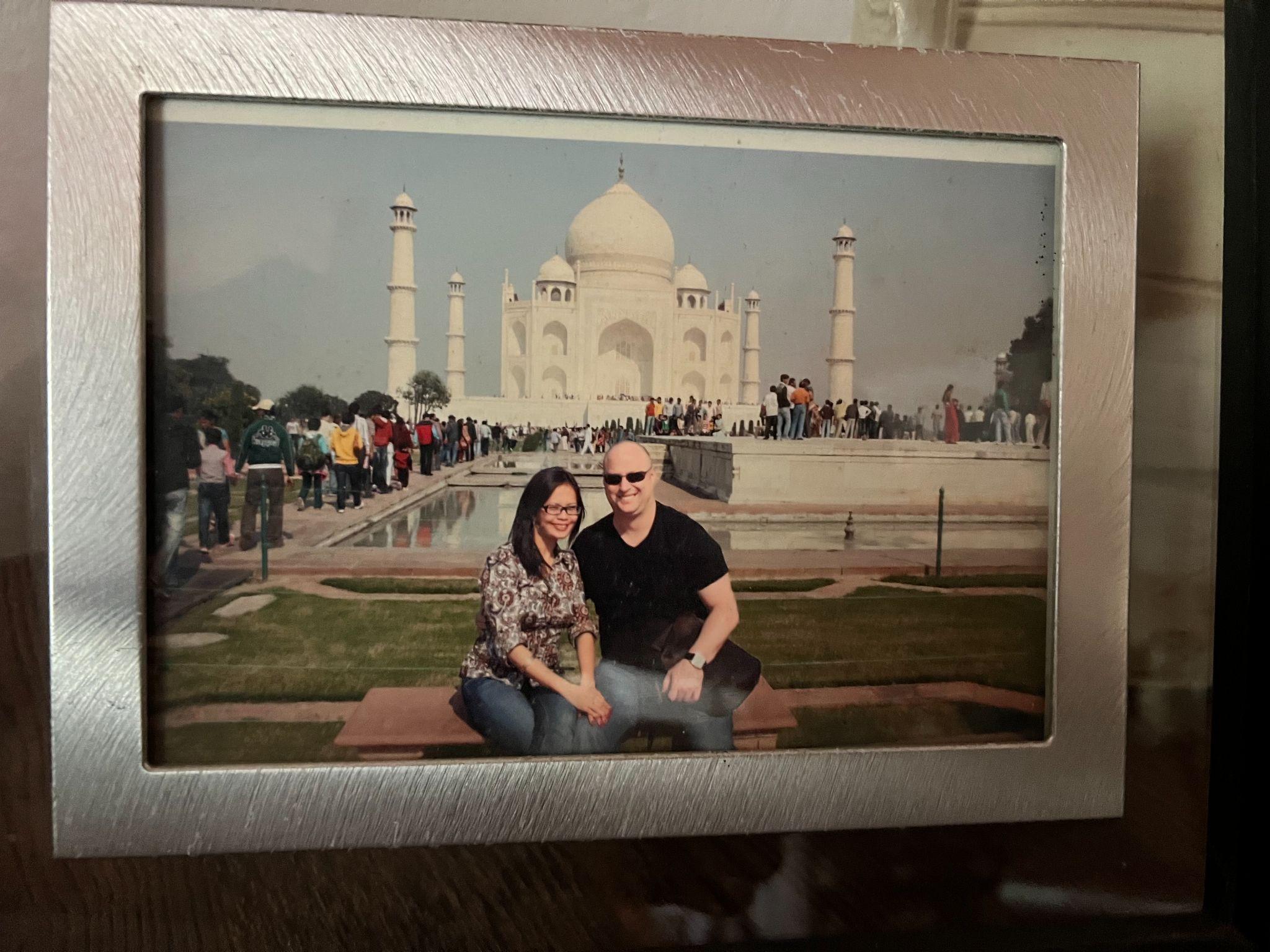
Posted August 05, 2025
By Sean Ring
Why Trump’s Tantrum Pushes India Away
This is the bane of watching Trump 47.
Yesterday, I wrote how thrilled I was he fired the useless head of the Bureau of Labor Statistics. It was an agency that needed a damn good sweeping. Good Trump!
Today, I’m scratching my head, wondering why The Donald wants to mess with India. There’s no upside to this trade, unless you count Lindsay Graham’s blessing. And one of my golden rules is that whenever Lindsay Graham is happy, you know it’s bad policy.
Here’s the offending post:

He then followed up:

This is positively asinine.
Former US Ambassador to India Eric Garcetti in 2024 said, "India bought Russian oil because America wanted it to buy the oil at a price cap. That was not a violation. America didn't want the price of oil to go up."
And why not? Because that would be massively inflationary.
Let me get into the myriad potential consequences of Trump’s tantrum. But first, my views.

Pam and I at the Taj Mahal in 2012. Credit: Sean Ring
India and Me
In the 13 years I lived in Asia, I visited India at least a dozen times. I used to teach banking graduates and private bankers in Delhi, Gurgaon, Mumbai, Pune, Chennai, and Jodhpur. It’s a country one-third the size of America, but with roughly four times the population. According to Encyclopedia Britannica, that’s like taking the Great Plains region of North America and filling it with 1.4 billion people.
Spending time in India doesn’t make me an expert on Indian politics. But while I was there, I observed a few things.
One is that the poverty is crushing. Sorry, Western “poverty” and Indian poverty are not the same thing. You can’t imagine the disease and squalor much of the Indian population lives in. If you’ve ever heard of Westerners traveling to India and getting sick and dying, this is the reason. So getting resources on the cheap is a national imperative for them.
The second thing is that Indians from different parts of the country need to speak English to communicate with each other. (Score one for the British Empire!) While India has only two official languages (Hindi and English), it has over 120 major languages, more than 270 mother tongues, and over 19,500 dialects. Think doing business there is easy?
The third thing is that while India may be poor on a per capita basis, it’s a fiercely proud country that’s utterly sick of Westerners interfering with its business. (Minus one for the British Empire and its successor, the American Empire.)
I haven’t been there for ten years, but India left a lasting—and positive—impression on me. It’s a rising power caught between the liberal West and the authoritarian East. And the choice isn’t clear-cut. This is why I think The Donald needlessly antagonized a potentially powerful ally.
Here are five non-anecdotal reasons:
1. Throwing Away a Growing Strategic Partnership
Just months ago, in February 2025, Trump welcomed Indian Prime Minister Narendra Modi to the White House. The two heralded a new era of energy, defense, and trade cooperation, backed by a bilateral target labeled “Mission 500” — $500 billion in trade by 2030. That goodwill is now evaporating. Trump's recent tirade against India's Russian oil buys and the surprise 25% tariffs on Indian exports have blindsided New Delhi, eroding trust and goodwill in what was a long‑term strategic pivot toward the U.S.
Remember, India could only make this arbitrage trade because of the U.S.’s stupid policy toward Russia.
Strategic alignment with India has served U.S. interests—from countering China in the Indo-Pacific to joint anti-terrorism efforts and cooperation in space and technology. Trump’s flailing about is turning India into a reluctant rival rather than a partner. It’s an American own-goal.
2. Economic Self-Sabotage
India is among America’s largest export markets. In 2021–22, U.S. goods to India exceeded $39 billion, and imports from India were more than $73 billion, making both sides have skin in the game. Analysts warn a 25% tariff would hit a wide swath of exports—pharmaceuticals, automotive parts, pearls, machinery—impacting roughly 87% of Indian goods headed to the U.S.
Why are we taxing countries that have a positive trade balance with us? Good question.
Citigroup projects Indian export losses of around $7 billion annually under a full tariff war. This doesn’t just burn goodwill, it risks kicking the U.S. economy in the goolies, too.
3. Diplomatic Hypocrisy and Trust Erosion
Trump has wrongly labeled India’s economy “dead” and claimed India doesn’t care about Ukrainian fatalities—comments Indian leaders and analysts rightly see as ridiculous, especially as the U.S. and EU themselves continue trading oil with Russia. India’s Ministry of External Affairs blasted U.S. and EU criticism as “unjustified and unreasonable.” I’d add “hypocritical,” myself.
Former foreign secretary Shyam Saran called Trump’s approach “a nightmare” that undermines India’s national sovereignty, warning against giving any foreign leader veto power over India’s independent foreign policy.
4. Placing Modi in an Impossible Domestic Bind
Trump’s demands put Modi in a lose‑lose position. Accept U.S. hardline demands to curb oil imports from Russia, and risk massive domestic backlash and accusations of bowing to Western coercion. Reject them, and face crippling tariffs and U.S.-led diplomacy that undermines his credibility.
Indian opposition leaders slammed Modi’s passive response, with Congress calling Trump’s comments “nonsense” and accusing Modi of being silent while India was under verbal assault. The political pressure on Modi is escalating fast.
5. Opening the Door for Adversaries
By choosing this moment to cozy up to Pakistan—brokering energy deals, public engagements with Pakistani military leadership at the White House, and taking credit for a ceasefire that India never recognized—Trump has rattled India even further. The perceived tilt toward Pakistan at India’s expense has revived old wounds reminiscent of the Nixon-era low in U.S.‑India relations.
This risks pushing India closer—if only grudgingly—to China and Russia as part of a broader realignment strategy. Trump’s transactional approach is creating issues that clash with long-term strategic interests, like keeping the BRICS at bay.
Bottom Line: A Diplomatic and Economic Self‑Inflicted Wound
Trump’s antagonism toward India is a diplomatic own goal with far-reaching risks. It dismantles nascent strategic cooperation forged over the years and risks derailing ambitious trade targets. It threatens global supply chains and U.S. healthcare costs. It betrays principles of sovereign decision-making and makes it easy to accuse the U.S. of hypocrisy. It drags Indian Prime Minister Modi into political jeopardy back home. And it exacerbates geopolitical alignments in which India may feel compelled to hedge more heavily toward U.S. rivals.
If Trump intended to "send a message," the message now echoes as a warning: antagonizing a rising democracy as big as India will backfire spectacularly.
What Now?
The U.S. should back away from toxic rhetoric and unintended escalation. It should also return to back-channel diplomacy and multilateral consultation, not ultimatums. Finally, and most importantly, the U.S. needs to stop coercing allies. Refocus instead on shared interests like security, tech, and energy.
With that said, India should avoid Canada’s fate and keep cool, avoiding tit‑for‑tat escalation. India should also use multilateral forums (G20, Quad) to underline strategic autonomy. And by all means, use BRICS to keep options open.
Wrap Up
Once hailed as a potential U.S.–India bromance reboot, this confrontation risks reversing all the goodwill and gains from the Modi‑Trump meeting earlier this year. Instead, Trump’s saber-rattling on tariffs and oil markets is positioning the U.S. as a meddlesome bully, pushing India toward the very axis of Russia-China that the U.S. aims to contain.
This is economic intimidation dressed in populist bluster—and it just may cost the U.S. one of its most consequential partnerships this century.

A Sliver of Silver
Posted December 10, 2025
By Sean Ring

The Public Service of Pushing Brains Into Industry
Posted December 09, 2025
By Sean Ring

Did America Just Lose The Great Game?
Posted December 08, 2025
By Sean Ring

L'oro dell'Italia
Posted December 05, 2025
By Sean Ring

The Border Threat No One Saw Coming
Posted December 04, 2025
By Sean Ring

